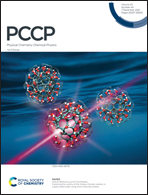An ab initio anharmonic approach to IR, Raman and SFG spectra of the solvated methylammonium ion†
Abstract
The methylammonium ion (CH3NH3+, or noted as MA–H+) is one of the smallest organic ammonium ions that play important roles in organic–inorganic halide perovskites. Despite the simple structure, the vibrational spectra of MA–H+ exhibit complicated features in the 3 μm region which are sensitive to the solvation environment. In the present work, we have applied the ab initio anharmonic algorithm at the CCSD/aug-cc-pVDZ level to simulate the IR and Raman spectra of the solvated methylammonium ion, MA–H+⋯X3, where X denotes the solvent molecules, to understand the Fermi resonance mechanism in which the overtones of NH bending modes are coupled with the fundamentals of NH stretching modes. The spectral features of the solvated clusters with proper solvent species resemble those observed in the perovskite crystal, indicating that they have similar solvation environments and hydrogen bond interactions. Therefore, a linkage between the gas-phase cluster models and the condensed-phase materials can be established, and our simulations and anharmonic analyses help in interpreting the spectral assignments of the observed IR and Raman spectra of perovskites reliably. Furthermore, we have extended this approach to the SFG spectra to demonstrate the selective appearance of bands depending on both the beam polarization configurations and the symmetry of vibrational modes.



 Please wait while we load your content...
Please wait while we load your content...